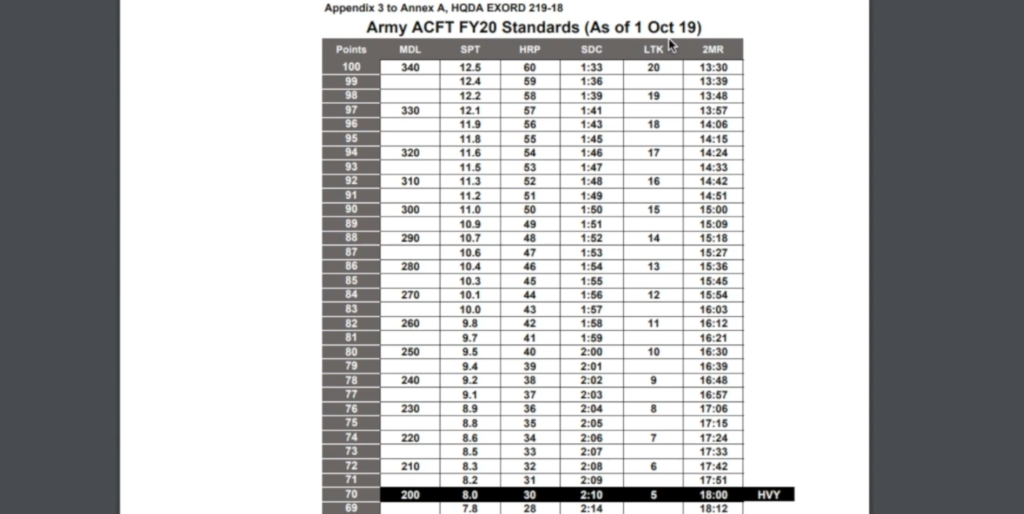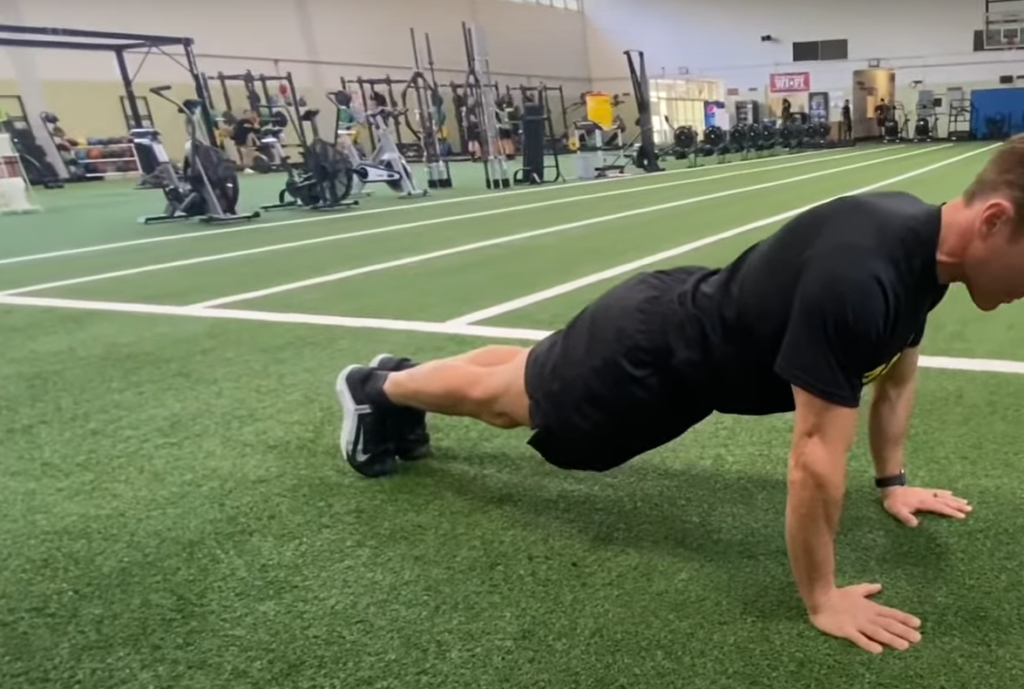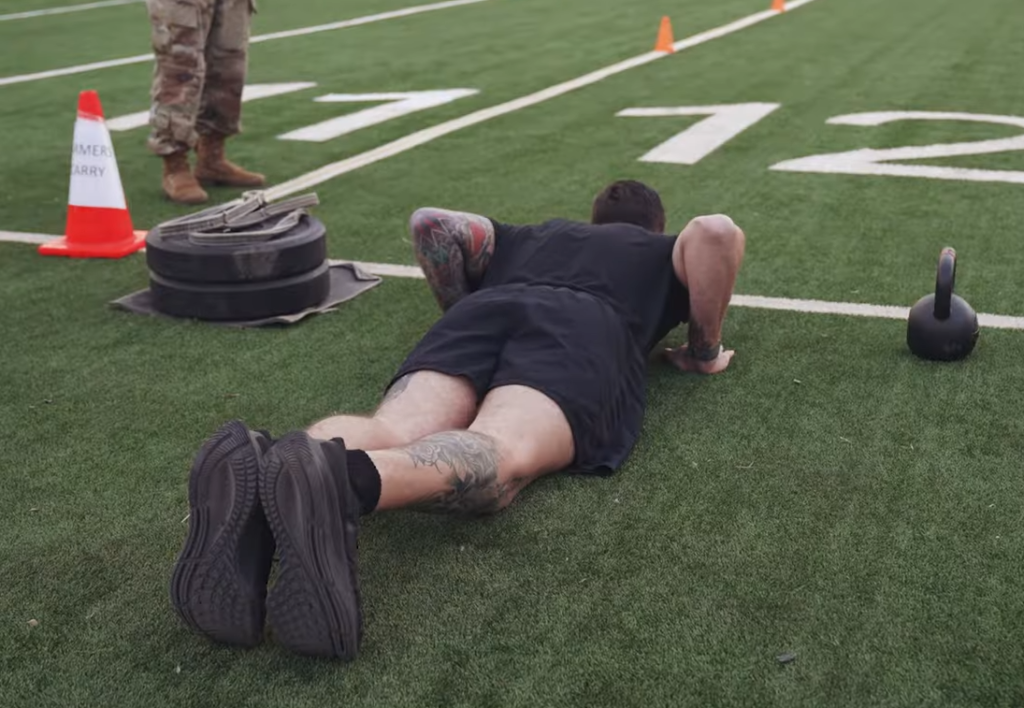The Army Combat Fitness Test (ACFT) represents a significant shift from the traditional Army Physical Fitness Test, ushering in a modern era of military fitness standards designed for combat readiness. In this comprehensive guide, we delve deep into the multifaceted ACFT standards, a keen reflection of the demands placed upon today’s soldiers.
Our exploration will provide an in-depth understanding of each component, scoring methodologies, and the rationale behind the rigorous benchmarks set for service members. Whether you’re a seasoned soldier, a recruit, or a civilian looking to comprehend military fitness, “ACFT Standards: Everything You Should Know” promises a thorough briefing on what it takes to be combat-fit in the United States Army.
What Is ACFT?
[tds_note]The Army Combat Fitness Test (ACFT) stands as a pivotal evolution in the United States Army’s approach to assessing the physical readiness of its soldiers [1]. Introduced to replace the long-standing Army Physical Fitness Test (APFT), the ACFT is a comprehensive and demanding evaluation designed to better reflect the physical demands of modern warfare.[/tds_note]

Background
The ACFT was officially adopted in 2019, marking the culmination of years of research and development. The decision to replace the APFT arose from a recognition that the nature of warfare and the demands placed on soldiers have evolved.
The new test aims to provide a more accurate representation of a soldier’s combat fitness by incorporating a diverse set of exercises that mimic the physical challenges encountered in real-world military scenarios.
Components of the ACFT
Unlike its predecessor, which primarily focused on push-ups, sit-ups, and a two-mile run, the ACFT comprises six challenging events. These events are:
- Three-Repetition Maximum Deadlift (3RM DL): This assesses a soldier’s ability to lift and carry heavy loads, simulating the demands of carrying equipment and wounded comrades on the battlefield;
- Standing Power Throw: Soldiers throw a 10-pound medicine ball backward over their heads for distance, testing explosive strength and coordination;
- Hand-Release Push-Up: This variation of the push-up ensures proper form and assesses upper body strength;
- Sprint-Drag-Carry (SDC): Combining various movements, the SDC event assesses a soldier’s agility, speed, and overall fitness;
- Leg Tuck: Hanging from a bar, soldiers must bring their knees to their elbows, testing core strength and endurance;
- Two-Mile Run: Similar to the previous test, this assesses aerobic endurance [2];
The Rationale
The ACFT is not merely a change in testing protocol; it reflects a shift in military philosophy. The goal is to ensure soldiers are not only physically fit but also prepared for the unpredictable challenges they may face in combat. By incorporating a broader range of exercises, the ACFT provides a more holistic view of a soldier’s capabilities.
Implementation Challenges
While the ACFT has been praised for its thoroughness, its implementation has not been without challenges. Critics argue that the test may disproportionately affect certain demographics, potentially impacting retention and recruitment efforts. Addressing these concerns is crucial to maintaining a fair and effective evaluation system.
What Is the APFT vs. ACFT?
The transition from the Army Physical Fitness Test (APFT) to the Army Combat Fitness Test (ACFT) signifies a paradigm shift in how the United States Army assesses the physical readiness of its soldiers. Understanding the key differences between these two tests is essential for grasping the evolution in military fitness evaluation [3].
APFT: The Traditional Standard
The APFT, a long-standing staple in the Army’s fitness assessment, comprised three core elements: push-ups, sit-ups, and a two-mile run. These components aimed to measure upper body strength, core endurance, and cardiovascular fitness, respectively. While the APFT served as a basic indicator of overall fitness, its simplicity led to criticism for not adequately reflecting the physical demands of modern warfare.

ACFT: A Comprehensive Approach
The ACFT, introduced in 2019, emerged as a response to the evolving nature of military operations. Unlike the APFT, the ACFT features a more diverse set of six events, each targeting specific physical attributes crucial for combat readiness:
- Three-Repetition Maximum Deadlift (3RM DL): Evaluates the ability to lift and carry heavy loads, simulating real-world scenarios like transporting equipment or injured comrades;
- Standing Power Throw: Assesses explosive strength and coordination by requiring soldiers to throw a 10-pound medicine ball backward for distance;
- Hand-Release Push-Up: Ensures proper form while testing upper body strength;
- Sprint-Drag-Carry (SDC): Combines various movements to assess agility, speed, and overall fitness;
- Leg Tuck: Hanging from a bar, soldiers perform a knee-to-elbow movement, testing core strength and endurance;
- Two-Mile Run: Similar to the APFT, this event assesses aerobic endurance;
Rationale Behind the Transition
The shift from APFT to ACFT reflects a broader understanding of the multifaceted challenges soldiers face on the battlefield. The ACFT aims to provide a more accurate and comprehensive evaluation of a soldier’s combat readiness, addressing the limitations of the simpler APFT.
Implications and Challenges
While the ACFT has been praised for its thoroughness, it has not been without controversy. Some critics argue that the new test may disproportionately impact certain demographics, potentially affecting recruitment and retention. Ongoing efforts to address these concerns are essential to ensure the fairness and effectiveness of the ACFT.
The New Army Combat Fitness Test In 2024
The U.S. Army has implemented a revised Army Combat Fitness Test (ACFT) that went into effect starting April 1, 2022 [4]. This new version was adapted based on data from 630,000 sample ACFT test scores and information collected by the RAND Corporation. The updated test includes a variety of exercises designed to better assess the physical readiness of soldiers for combat tasks.
As reported by the official Army website, the revision process is not static; the Army acknowledges the need for the ACFT to evolve over time, unlike its predecessor — the Army Physical Fitness Test (APFT) — which remained largely unchanged for 40 years.
The National Defense Authorization Act (NDAA) gave the Army up to 18 months to implement the changes to the ACFT, which also requires the Army to report back to Congress on the test’s progress. This suggests there is an ongoing evaluation and possibly more updates to the fitness testing protocol.
The Army Times highlighted that active duty soldiers were required to take a record ACFT by April 2023, while Reserve and Guard soldiers have been given until April 2024 to complete their record tests. This staggered approach allows for a transition period for different components of the Army.
Further changes to the ACFT, as covered by Task & Purpose, indicate that Congress has mandated the Army to “increase” its fitness standards for combat soldiers, although details regarding whether these standards will be gender-neutral or gender-specific were not clear.
Additionally, another report from the Army Times in June 2023 mentioned that a Senate committee had advanced a bill that could potentially change the future of the ACFT. This suggests that there have been ongoing discussions and potential legislative involvement in the test’s development.
Finally, Military.com reported that the new ACFT includes exercises such as deadlifts, hand-release push-ups, and planks, among others. These exercises are designed to better simulate combat tasks and assess the necessary strength, endurance, and agility required of soldiers.
In summary, the ACFT in 2024 represents the latest effort by the U.S. Army to modernize its fitness standards and ensure its soldiers are prepared for the physical demands of combat. The ACFT is expected to continue evolving as the Army assesses its effectiveness and receives feedback from legislative bodies.
Test Requirements According to the ACFT Manual:
1) Uniform
The uniform requirements for the ACFT are typically designed to simulate conditions similar to combat training.
Soldiers are usually required to wear their standard physical fitness uniform, which may include:
- Army Physical Fitness Uniform (APFU) shorts or long pants;
- APFU short or long-sleeve T-shirt;
- Appropriate running shoes;
- Reflective belt (if the test is conducted during hours of limited visibility);
- Other weather-appropriate gear as authorized (e.g., gloves, beanie);
Headgear, military attire like body armor or load-bearing equipment, and jewelry other than an authorized wristwatch, ID bracelet, and two rings are generally not permitted during the test.
2) Preparation
Before the ACFT, soldiers are encouraged to engage in a proper warm-up routine to prepare the body for the rigors of the test and to reduce the risk of injury. This warm-up may include:
- Dynamic stretching;
- Light cardio exercises;
- Practice drills that mimic the movements of the test events;
The ACFT may also require setting up the testing area appropriately, including:
- Positioning of equipment for each event;
- Ensuring the testing site is flat and free of debris;
- Proper briefing on each event’s standards and scoring [5];
3) Training
For training, soldiers are advised to follow a holistic fitness program that includes strength, endurance, and mobility training tailored to the demands of each event included in the ACFT.

The components of the ACFT as of the previous updates typically include:
- 3-Repetition Maximum Deadlift (MDL): Measures lower body strength;
- Standing Power Throw (SPT): Assesses explosive power;
- Hand-Release Push-Up – Arm Extension (HRP): Tests upper body endurance;
- Sprint-Drag-Carry (SDC): Gauges speed, agility, and muscular endurance;
- Leg Tuck (LTK) or Plank: Evaluates core strength (Plank was introduced as an alternative to the Leg Tuck);
- Two-Mile Run (2MR): Assesses cardiovascular endurance;
The Army provides training guides and resources to help soldiers prepare for the ACFT, such as the “ACFT Training Guide” available through official Army channels.
It is important to note that these requirements could be subject to change. To get the most accurate and up-to-date information on the current ACFT uniform, preparation, and training requirements, please consult the latest ACFT Field Manual or reach out to an official Army representative.
Army Combat Fitness Test Scoring:
Black – “Heavy” Physical Demands
The Army Combat Fitness Test (ACFT) is a new physical fitness test that was implemented in 2020. The ACFT is designed to be more job-relevant than the previous test, the Army Physical Fitness Test (APFT).
The ACFT consists of six events:
- Three-repetition maximum deadlift (MDL);
- Standing power throw (SPT);
- Hand-release push-up (HRPU);
- Sprint-drag-carry (SDC);
- Plank hold (PLK);
- Two-mile run (2MR);
[tds_info]Each event is scored on a scale of 0 to 100 points. The minimum passing score for the ACFT is 360 points. Soldiers who score below 360 points are considered to be in the “Black” category, which means that they do not meet the Army’s physical fitness standards.[/tds_info]
Soldiers in the Black category are required to undergo remedial physical training (RPT). RPT is designed to help soldiers improve their fitness so that they can meet the Army’s standards. Soldiers who fail to improve their fitness after completing RPT may be subject to disciplinary action, up to and including discharge from the Army.
Gray – “Significant” Physical Demands
Soldiers who score between 360 and 420 points on the ACFT are considered to be in the “Gray” category. This means that they meet the Army’s physical fitness standards, but they are not in peak physical condition. Soldiers in the Gray category are encouraged to continue to improve their fitness so that they can move into the Gold category [6].
Gold – “Moderate” Physical Demands
Soldiers who score 420 points or higher on the ACFT are considered to be in the “Gold” category. This means that they are in peak physical condition and are able to meet the demands of their job. Soldiers in the Gold category are eligible for promotion and other benefits.
The ACFT scoring system is designed to ensure that all soldiers are physically fit to meet the demands of their job. The Black category identifies soldiers who need to improve their fitness, while the Gray and Gold categories identify soldiers who are meeting or exceeding the Army’s standards.

Required ACFT Events And Exercises (As Of 2024):
Three-Repetition Maximum Deadlift (MDL)
This event involves lifting a weight using a hex bar (also known as a trap bar). The soldier performs three repetitions of the deadlift at the maximum possible weight. This exercise tests lower body strength.
Standing Power Throw (SPT)
Soldiers throw a 10-pound medicine ball backwards and overhead for distance. The standing power throw measures explosive power, which is crucial for tasks such as lifting, carrying, and throwing.
Hand-Release Push-Up (HRP)
In this modified push-up event, soldiers must lift their hands off the ground briefly at the bottom of the push-up. This assesses upper body endurance and additional functional fitness over the traditional push-up.
Sprint-Drag-Carry (SDC)
Soldiers are required to sprint, drag a sled, carry kettlebells, and then perform lateral shuffles and sprints again. This event simulates a variety of physical movements and tasks soldiers may encounter on the battlefield.
Plank
The plank event measures core strength and stability. Soldiers must maintain a plank position for a set period of time. This replaced the leg tuck event to accommodate a broader range of body types and fitness levels.
Two-Mile Run (2MR)
This is a cardiovascular endurance test where soldiers run two miles as fast as possible. Cardiovascular endurance is vital for many military operations, especially those involving dismounted movement over distance.
It’s important to note that the ACFT is designed to be a gender-neutral test, providing a more accurate assessment of a soldier’s physical readiness for combat than its predecessor, the APFT (Army Physical Fitness Test). Information from Task & Purpose suggests that there has been legislative action mandating the Army to “increase” its fitness standards for combat roles, although it is unclear what form these increased standards might take.
The implementation timetable indicates that all Active Duty and Active Guard Reserve (AGR) soldiers were required to start taking record ACFTs from October 1, 2022 [7]. Reserve and National Guard units have until April 2024 to complete their record tests, per the information from Army Times.
For specific training workouts to maximize performance on the ACFT, the SFNationalGuard website provides specialized exercises targeting the muscles and movements involved in each ACFT event.
Soldiers and those interested in maintaining or improving their fitness according to the ACFT standards can follow tailored workout routines that include exercises like deficit Romanian deadlifts, heavy barbell rows, and various deadlift progressions to prepare for the three-repetition maximum deadlift, among other targeted workouts for each event.

Why Were Leg Tucks Removed?
The leg tucks were removed from the Army Combat Fitness Test (ACFT) for several reasons:
- Discrimination Concerns: Research suggested that the leg tuck may have inadvertently discriminated against women. Women, on average, were less successful at the exercise compared to their male counterparts, leading to a significant disparity in test results which raised concerns about fairness and inclusivity;
- High Failure Rates: The leg tuck was reported as the “number one failed event for both men and women,” according to PBS. Older soldiers also struggled significantly with the event. This high failure rate indicated that the leg tuck may not have been an effective measure of overall fitness for a broad population of soldiers;
- Research Findings: The decision to eliminate the leg tuck was influenced by findings from studies, such as the one conducted by the RAND Corporation. These studies aimed to evaluate the effectiveness and appropriateness of various components of the ACFT;
- Public Feedback: Anecdotal evidence from platforms like Reddit suggests that there was recognition that the minimum standards could not be lowered below the previous requirement, which was at least one leg tuck. This created a challenge in accommodating all soldiers to meet the minimum physical fitness standard;
- Enabling a Broader Inclusion: By replacing the leg tuck with the plank, the Army sought to implement a fitness test that could accommodate a wider range of body types and fitness levels without compromising the core strength assessment component of the test;
- Implementation of Revised Standards: The Army made other key changes along with the replacement of the leg tuck, including updated age-and-gender-performance normed scoring scales. These changes were part of a broader effort to make the ACFT more equitable and reflective of the physical demands placed on soldiers;
ACFT Scoring Standards As Of 2024:
Most Recent Standards (March 23, 2022):
Age 17-21 Male:
- 3-Repetition Maximum Deadlift – 340 lbs (100 points – maximum) and 140 lbs (60 points – minimum);
- Standing Power Throw – 12.5 meters (100 points – maximum) and 4.5 meters (60 points – minimum);
- Hand-Release Push-Ups – 60 reps (100 points – maximum) and 10 reps (60 points – minimum);
- Sprint-Drag-Carry – 1:33 minutes (100 points – maximum) and 3:00 minutes (60 points – minimum);
- Leg Tuck or Plank – 20 reps or 3:40 min (100 points – maximum) and 1 rep or 1:20 min (60 points – minimum);
- 2-Mile Run – 13:30 minutes (100 points – maximum) and 21:00 minutes (60 points – minimum) [8];
Age 17-21 Female:
- 3-Repetition Maximum Deadlift – 210 lbs (100 points – maximum) and 120 lbs (60 points – minimum);
- Standing Power Throw 4.6 meters – (100 points – maximum) and 4.5 meters (60 points – minimum);
- Hand-Release Push-Ups – 40 reps (100 points – maximum) and 10 reps (60 points – minimum);
- Sprint-Drag-Carry – 2:15 minutes (100 points – maximum) and 3:30 minutes (60 points – minimum);
- Leg Tuck or Plank – 10 reps or 2:45 min (100 points – maximum) and 1 rep or 1:20 min (60 points – minimum);
- 2-Mile Run – 17:30 minutes (100 points – maximum) and 24:30 (60 points – minimum);
Key Points for 2024:
- Potential Changes: The ACFT scoring standards could potentially change in 2024, as directed by the 2024 National Defense Authorization Act (NDAA). The NDAA requires the Army to implement “higher minimum standards” for combat troops within 18 months of the bill’s enactment;
- Combat MOS Focus: These potential changes are likely to focus on raising minimum standards for combat-related Military Occupational Specialties (MOS);
- Official Updates: It’s essential to stay updated with official announcements from the Army to obtain the most accurate and up-to-date scoring standards for 2024;
Recommendations:
- Monitor Official Sources: Regularly check the Army’s official ACFT website for the latest information and any updates to scoring standards;
- Consult with Leadership: If you’re currently serving in the Army, reach out to your unit’s leadership for guidance and clarification on ACFT standards and any potential changes for 2024;

Top ACFT Training Tips
General Tips:
- Focus on a well-rounded training program: Incorporate strength training, cardio, core work, and mobility exercises into your routine;
- Practice the specific movements: Don’t just rely on general fitness. Regularly practice the ACFT events to improve your technique and efficiency;
- Listen to your body: Take rest days when needed to avoid injury and overtraining;
- Fuel your body properly: Eat a healthy diet with plenty of fruits, vegetables, and whole grains. Stay hydrated by drinking plenty of water;
- Get enough sleep: Aim for 7-8 hours of sleep per night to allow your body to recover and rebuild;
Event-Specific Tips:
3-Repetition Maximum Deadlift:
- Focus on proper form to avoid injury
- Use compound exercises like squats, rows, and overhead presses to build overall strength;
- Practice deadlifts regularly with gradually increasing weights;
Standing Power Throw:
- Practice explosive movements like box jumps, jumpsquats, and medicine ball throws;
- Work on your core strength and stability;
- Practice the throwing motion with a weighted medicine ball;

Hand-Release Push-Ups:
- Build upper body strength with exercises like push-ups, rows, and pull-ups;
- Practice different push-up variations to target different muscle groups;
- Use negatives or incline push-ups if you can’t do full push-ups yet;
Sprint-Drag-Carry:
- Practice sprinting, sled pushes/drags, and sandbag carries individually to improve each component;
- Work on your overall leg strength and power with exercises like squats, lunges, and box jumps;
- Practice transitioning smoothly between each part of the event;
Leg Tuck or Plank:
- Build core strength and endurance with exercises like planks, sit-ups, and Russian twists;
- Practice holding a plank for longer and longer durations;
- If you can’t do leg tucks, focus on improving your plank hold time;
2-Mile Run:
- Gradually increase your running distance and pace over time;
- Incorporate interval training and tempo runs into your routine;
- Practice running on the terrain you’ll be tested on (e.g., grass, track);
Remember, consistency is key! Stick to your training program, listen to your body, and you’ll be well on your way to ACFT success.

FAQ:
1. What score do you need to pass the ACFT?
The minimum passing score for the ACFT is typically 60 points per event, totaling a minimum of 360 points out of a maximum 600 points. This can vary based on your Military Occupational Specialty (MOS) and unit requirements.
2. How does the ACFT work?
The ACFT consists of six events designed to measure strength, endurance, power, and agility. Soldiers must complete all events in sequence during a single testing session.
3. How can you pass the ACFT?
To pass the ACFT, focus on regular, balanced training that includes strength, cardio, and flexibility exercises. Practice specific ACFT events to improve your technique and performance.
4. What are 3 alternate events for the ACFT?
As of my last update, there were no alternate events for the ACFT. However, the plank was introduced to replace the leg tuck as a core strength assessment exercise.
5. Is the ACFT easier than the APFT?
Ease is subjective and varies between individuals. The ACFT is designed to be more comprehensive and job-specific than the APFT, so some may find it more challenging while others may find it aligns better with their training.
6. What happens if you fail the ACFT?
If you fail the ACFT, you will likely be required to retake the test after a period of additional training. Repeated failures can have career implications.
7. Can you wear gloves during the ACFT?
Yes, gloves can be worn during events that require grip, like the deadlift, to protect your hands and improve your grip.
8. Can you change your shoes during the ACFT?
While the regulations regarding changing shoes during the ACFT are not explicitly stated, practicality suggests wearing a versatile pair of athletic shoes that can accommodate all events.
9. What is the best way to prepare for the ACFT?
A balanced training regimen that includes strength training, aerobic and anaerobic conditioning, and practice of the specific ACFT events is the best way to prepare.
10. What is the ACFT regulation for 2024?
For the most current 2024 regulation, please consult the latest U.S. Army publications or their official website.
11. What is a good ACFT score?
A good ACFT score is generally considered to be above the minimum passing score, with scores closer to 100 on each event being indicative of excellent fitness.
12. How do you prepare for ACFT the day before?
Rest, hydrate, eat nutritious foods, and perhaps do some light stretching or a low-intensity workout to keep muscles active without causing fatigue.
13. What is the most failed ACFT event?
Previously, the leg tuck was considered the most failed event, but this may have changed with the introduction of the plank.
14. What should you eat during ACFT?
During the ACFT, focus on staying hydrated and maybe have a light snack, such as a banana or energy bar if needed, especially if there’s a long wait between events.
15. What’s the max deadlift for ACFT?
The maximum score for the deadlift event was traditionally achieved at 340 pounds for three repetitions.
16. Has anyone scored a 600 on the ACFT?
Yes, there have been reports of soldiers scoring a perfect 600 on the ACFT, although it is relatively rare and requires peak physical condition.
17. Is a 500 ACFT good?
Yes, a score of 500 is considered very good as it is significantly above the minimum passing score.
18. What is the 540 rule for ACFT?
There isn’t an established “540 rule” for the ACFT; this may be a confusion with scoring requirements or standards, which can vary.
19. How many people fail the ACFT?
Failure rates vary widely depending on the population and time frame examined. Initially, failure rates were higher, particularly for certain events and demographics, but with training and adaptation, these rates may decrease.
20. What is a perfect PT score in the Army?
A perfect PT score in the Army’s Physical Fitness Test (APFT) was traditionally 300. However, for the ACFT, a perfect score is 600.
21. Can you take the ACFT in the rain?
Yes, the ACFT can be conducted in inclement weather unless conditions are deemed unsafe.
22. What is the max time on an ACFT run?
The maximum allowable time for the 2-mile run event in the ACFT has varied in different versions of the test but is usually around 21 minutes.
23. Can soldiers wear headphones during the ACFT?
No, soldiers are not permitted to wear headphones during the ACFT.
24. Do rangers use ACFT?
Rangers, like all Army soldiers, are required to take the ACFT, as it is the standard fitness test across the U.S. Army.
25. Can you wear a lifting belt during ACFT?
Wearing a lifting belt is not allowed during the ACFT to ensure uniform testing conditions and equitable scoring.
26. What are the risks of ACFT?
Risks include typical exercise-related injuries such as strains, sprains, and overuse injuries. Proper training and technique can mitigate these risks.
27. Is the ACFT gender-neutral?
The ACFT was designed to be a gender-neutral test, assessing performance standards that reflect the demands of combat tasks rather than gender-specific requirements.
Useful Video: How to: Find YOUR Army ACFT Standards by MOS – (4 simple steps)
References:
- https://www.armycombatfitnesstest.com/scoringstandards
- https://www.army.mil/acft/#faq
- https://www.military.com/military-fitness/acft-score-chart-resources-and-how-administer
- https://www.military.com/military-fitness/army-fitness/army-combat-fitness-test-acft-score-chart
- https://maxmyacft.com/the-ultimate-informational-guide-to-the-acft/
- https://uniquewebcopy.com/acft-army-combat-fitness-test-faq/
- https://www.moaa.org/content/publications-and-media/news-articles/2022-news-articles/what-you-need-to-know-about-the-armys-new-fitness-test/
- https://www.militaryonesource.mil/military-basics/new-to-the-military/the-army-combat-fitness-test/






Leave a Reply